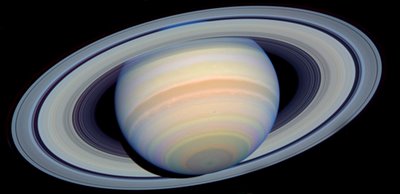Saturn

Saturn was the most distant of the five planets known to the ancients. In 1610, Italian astronomer Galileo Galilei was the first to gaze at Saturn through a telescope. To his surprise, he saw a pair of objects on either side of the planet. He sketched them as separate spheres and wrote that Saturn appeared to be triple-bodied.
Like Jupiter, Saturn is made mostly of hydrogen and helium. Its volume is 755 times greater than that of Earth. Winds in the upper atmosphere reach 500 meters (1,600 feet) per second in the equatorial region. (In contrast, the strongest hurricane-force winds on Earth top out at about 110 meters, or 360 feet, per second.) These super-fast winds, combined with heat rising from within the planet's interior, cause the yellow and gold bands visible in the atmosphere.
Saturn's ring system is the most extensive and complex in the solar system, extending hundreds of thousands of kilometers from the planet. In the early 1980s, NASA's two Voyager spacecraft revealed that Saturn's rings are made mostly of water ice, and they found 'braided' rings, ringlets, and 'spokes' - dark features in the rings that circle the planet at different rates from that of the surrounding ring material. Material in the rings ranges in size from a few micrometers to several tens of meters. Two of Saturn's small moons orbit within gaps in the main rings.
Saturn has 30 known natural moons and there are probably many more waiting to be discovered. Saturn's largest moon is Titan a bit bigger than the planet Mercury. Titan is shrouded in a thick, nitrogen-rich atmosphere that might be similar to what Earth's was like long ago. Further study of this moon promises to reveal much about planetary formation and, perhaps, about the early days of Earth. Saturn also has many smaller 'icy' moons. From Enceladus, which shows evidence of recent surface changes, to Iapetus, with one hemisphere darker than asphalt and the other as bright as snow, each of Saturn's moon is unique.
Like Jupiter, Saturn is made mostly of hydrogen and helium. Its volume is 755 times greater than that of Earth. Winds in the upper atmosphere reach 500 meters (1,600 feet) per second in the equatorial region. (In contrast, the strongest hurricane-force winds on Earth top out at about 110 meters, or 360 feet, per second.) These super-fast winds, combined with heat rising from within the planet's interior, cause the yellow and gold bands visible in the atmosphere.
Saturn's ring system is the most extensive and complex in the solar system, extending hundreds of thousands of kilometers from the planet. In the early 1980s, NASA's two Voyager spacecraft revealed that Saturn's rings are made mostly of water ice, and they found 'braided' rings, ringlets, and 'spokes' - dark features in the rings that circle the planet at different rates from that of the surrounding ring material. Material in the rings ranges in size from a few micrometers to several tens of meters. Two of Saturn's small moons orbit within gaps in the main rings.
Saturn has 30 known natural moons and there are probably many more waiting to be discovered. Saturn's largest moon is Titan a bit bigger than the planet Mercury. Titan is shrouded in a thick, nitrogen-rich atmosphere that might be similar to what Earth's was like long ago. Further study of this moon promises to reveal much about planetary formation and, perhaps, about the early days of Earth. Saturn also has many smaller 'icy' moons. From Enceladus, which shows evidence of recent surface changes, to Iapetus, with one hemisphere darker than asphalt and the other as bright as snow, each of Saturn's moon is unique.



